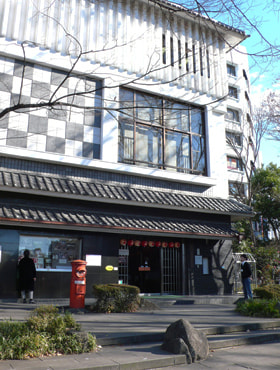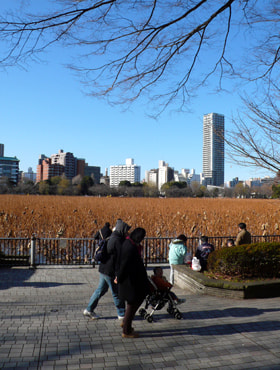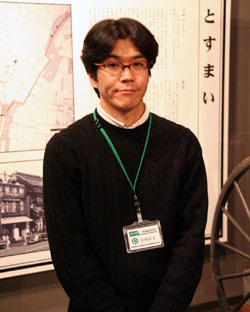
Hiroshi Ishii, a specialist at Taito City Shitamachi Museum
Ishii: Although typical local museums handle a broad range of local historic materials and cultures, we focus on so-called life history since modern times.
Q: We rarely distinguish academic materials from social ones. How are these exhibits positioned as academically valuable materials? In terms of research fields, is it sociocultural study or cultural history?
Ishii: Well, this museum specializes in exhibits relating to the Shitamachi area and Taito City.
Q: It might be apparent from photo books of the Shitamachi area in the Showa Period. Are a lifestyle and its pattern in the Shitamachi area significantly different from those in provincial cities?
Ishii: First of all, there is so-called the Shitamachi spirit. It is deeply related to the house type of the row house displayed on the first floor. For example, neighbors lived in houses that were separated by only a wall, so casual relationships and the Shitamachi spirit were nurtured. The basis of such house type was made in the Edo Period. However, an area where houses made of wood and paper were densely built up was easily damaged by a fire. Once a fire broke out, everything was destroyed, so there was no use in saving money. In other words, the house type was significantly related to the formation of the "Edo spirit," with which people "did not keep earnings overnight."
Q: In which area were those row houses and merchant houses, which are reproduced and displayed on the first floor, located in Taito City?
Ishii: They are not particular houses, but I heard that the research was conducted based on row houses located in Hashiba (Hashiba, Taito City).
Q: What is the feature of this museum?
Ishii: Living spaces are exhibited as they are. Each material is not exhibited separately, but scenes, such as that of the row house and merchant house on the first floor, are exhibited. Therefore, each material can be effectively displayed. For example, the advantage of this exhibition method is obvious in the scene of a life in winter. There are a Hibachi brazier and a Kotatsu foot warmer. Although today's children know Kotatsu, the fuel used in those days was completely different. Now, people are using electric Kotatsu, but this Kotatsu used charcoal as its fuel. A Shichirin cooking stove is placed at the entrance and a variety of appliances are stored in the closet. This appliance was used for smoothing wrinkles out of clothes by using a charcoal fire. It can be understood how charcoal was necessary in everyday life. If Kotatsu is separately exhibited, it is not so convincing. However, it can be possible to demonstrate that a charcoal fire was important and necessary as fuel in old times by reproducing its surrounding living space. Each appliance might not be so valuable, but its significance can be enhanced one another and its added value can be suggested by totally reproducing the living space. [continued in the upper right column]

Taito City Shitamachi Museum is located in a neighborhood near Ueno Shinobazu-no Ike Pond.
Q: Is the museum still collecting materials? Is the collection limited to those relating to Taito City rather than to a particular period?
Ishii: The collection is not limited. It is also difficult to assess materials related to everyday life. However, the museum does not exhibit materials such as those which were only used in Hokkaido. Most materials were used in various areas and Tokyo. There are not only household appliances but also, for example, many photographs, picture postcards, illustrations and colored woodblock prints. In this sense, the range of collection is somewhat wider.
Q: Visitors are from provinces and overseas, aren't they? In that case, their life experiences are somehow different. I think visitors from Kanto regions might feel nostalgic, but visitors from provincial areas have different impressions.
Ishii: I also think so. However, if you only look at appliances, it is not so different. Of course, Ueno being the place it is, many people in provincial areas have visited the museum. For example, various people wrote down their impressions on a notebook prepared by the museum. Many people wrote about nostalgic impressions other than differences with their experiences. It might be feelings related to Hibachi, a chest of drawers and smallness of rooms. The number of visitors who had impressions that there was something in common is greater than those who thought their places were different. [continued in the lower column]

Shinobazu-no Ike Pond facing the museum is a popular spot for casual strollers.
Ishii: In some cases, such materials were collected, but most materials were donated from individuals who contacted us. So most of them are used materials. In many cases, those materials were donated because contributors' parents died, contributors reached an advanced age and their children did not need such appliances, contributors relocated, or contributors rebuilt their old houses. Bandai, or a custodian's elevated seat in a bathhouse, is installed on the second floor of the museum. It was donated when a bathhouse closed down, and is the biggest material in this museum. Also, on the second floor, materials relating to Asakusa are exhibited at the corner of a reproduced coffeehouse. A secret book of street performance, made of coarse paper, is displayed there. It is said that, after a huckster demonstrated a suspicious performance, he coaxed innocent children to spend almost all money, except train fare, to buy the book, saying that the method of how to do the performance was written in this book and that the book should not be opened until the children went home. In this book, a method of cutting a chopstick into two pieces by a twisted-paper string is illustrated. The book was made in around 1899 and priced at 10 sen. The price of Soba noodles was around 1 sen at that time, so the book was fairly expensive. Although it is a downright lie, a statement on the book reads "approved by the Ministry of Home Affairs." Writer Kokichi Kitazono wrote in his essay that he was actually tricked to buy such a book at the precincts of Yasukuni Shrine. This kind of materials has scarcely been preserved. The museum has also collected such materials which people do not intentionally preserve. [ continued in the next page]

Hiroshi Ishii, a specialist at Taito City Shitamachi Museum














